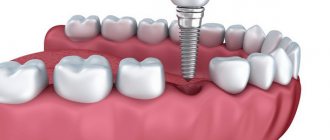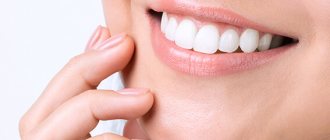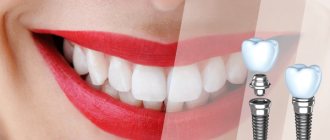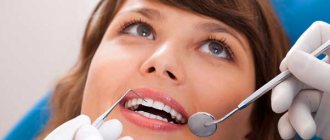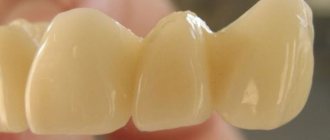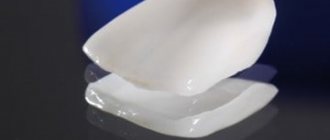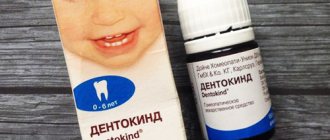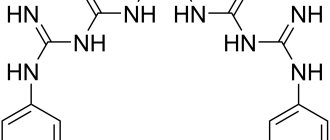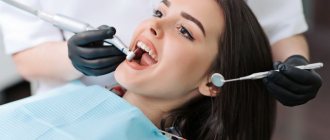01.12.2019
Dental implantation is a procedure for introducing an artificial titanium structure into the bone structure to replace a lost tooth root.
The surgical process is accompanied by a violation of the integrity of soft and hard tissues, which entails a stressful situation for the body.
The implantation process can be called complex from start to finish. And if the success of the operation itself depends on the professionalism of the implantologist and the individual characteristics of the body, then the recovery stage is controlled for the most part by the patient.
He must strictly follow not only hygiene recommendations and eliminate physical activity, but also properly prepare his diet.
POSTOPERATIVE PERIOD
Regardless of the method of installing a dental implant, during the recovery period it is important to adhere to all medical recommendations and prescriptions.
They must be observed especially carefully during the first 14 days after surgery.
Particular attention should be paid to nutrition during the period of restoration of damaged tissues. It is forbidden to eat any food for 2-3 hours after traumatic manipulations.
This is explained by the fact that an unhealed wound area remains in the oral cavity, into which food particles can fall and provoke the activation of inflammatory processes. There is a risk of early rejection of the structure.
Let's consider the basic rules of nutrition in the postoperative phase:
- The first meal is allowed 2 hours after the implantation procedure. With the classic method of implantation, surgical intervention involves incision of the gum tissue followed by suturing. If you start eating immediately after implantation of the structure, there is a high probability of rupture of the suture material. The wound may open, and along with food particles, pathogenic and pathogenic bacteria will enter the bloodstream, which threatens the development of undesirable consequences associated with a deterioration in overall health. After implantation according to the basal technique protocol, doctors allow you to eat after 1 hour. When used during tissue intervention under general anesthesia, the period of abstinence from food is 4 hours.
- The temperature of consumed food, water and drinks should be warm. Hot and cold foods should be avoided for a while.
Remember! Eating food until the anesthesia has completely worn off is unacceptable. While the tissues of the mouth are in a state of numbness, there is a risk of biting the gums or burning the mucous membrane.
Other useful tips:
- Completely review your usual diet and eliminate dishes that can create stress on the wound area. This will help protect the structure embedded in the bone from displacement.
- Foods high in calcium help speed up the implantation of the artificial root with the bone. You need to add them to your daily menu.
- In the first week after the procedure, it is advisable not to drink coffee or black tea. Such drinks can provoke bleeding from the wound.
- To eliminate the load, the opposite side must participate in the chewing process.
Important! After eating, you should rinse your mouth with clean water or a decoction of anti-inflammatory herbs. Moreover, the creation of vacuum pressure is unacceptable. Simply take the liquid into your mouth, hold it for a few seconds, and then spit it out.
What to do if a crown falls out -
The simplest option is when the crown falls out not because of carious destruction of the tooth tissue underneath, but because of poor cement fixation of the crown on the tooth. The main reasons for the loss in this case: mistakes by the dentist when fixing the crown with permanent cement, low clinical height of the crown (in this case, the crown will always fall out with regularity). In this case, it is enough to immediately contact your dentist to have a new crown fixed on your tooth.
1) What to do if a crown with a pin falls out -
Often, when preparing a tooth for prosthetics, a pin or stump inlay is fixed in the root canal. If your crown and pin fall out, this is again due to poor quality work by dentists. The fact is that severely damaged tooth crowns (before prosthetics with crowns) are restored by good dentists not with the help of pins, but with the help of stump inlays.
How a tooth is restored using a pin and filling -
Therefore, if the crown of your tooth was almost completely destroyed and it was restored with the help of filling material and a pin, the loss of the crown will be a pattern, because such a design is simply not able to withstand normal chewing pressure. By the way, no less often in such situations, the pins lead to a root fracture, after which the tooth is removed altogether.
If such a crown falls out, then the filling material with a pin sticking out of it remains inside the crown. Of course, it is possible to simply cement all this over again in the root canal (and we are sure that you will find dentists who will be ready to do this), but this is absolutely forbidden. Here you need to restore the tooth again - preferably with a stump tab, and then make a new crown. Otherwise, you will simply lose this tooth.
2) If the crown falls out along with the stump tab -
If a badly damaged tooth was restored not with a pin, but with a stump tab, the crown may also sometimes fall out. This is usually also due to dentist mistakes. The fact is that after fixing the stump tab in the root canal, many dentists, saving time, begin to file it with burs within 15 minutes and take an impression.
RECOMMENDED PRODUCTS
A competent approach to nutrition will help speed up the process of engraftment of the tooth root analogue. The optimal menu includes:
- Dairy products. Cottage cheese, kefir, yoghurt, sour cream are useful components of the patient’s diet after implantation. Calcium, which is part of the listed products, promotes the rapid recovery of all injured areas. Moreover, the element triggers the process of active growth of bone cells, which serve as a kind of foundation for firmly holding the artificial root.
- Puree, soft or liquid food. In the postoperative period, you can afford broths (meat, vegetables), pureed soups, crushed to a paste, peas or beans, cereals, vegetables processed in a blender, baby food, omelettes.
- Vitaminized food. It is recommended to consume as many vegetables and fruits as possible, brought to the state of emulsions using kitchen grinders.
Drinking recommendations:
- regular warm water is the best option (at least 2 liters per day);
- You can diversify your diet with several cups of green tea a day;
- Non-acidic, freshly squeezed fruit juices with low sugar content are also allowed by doctors in moderation.
Turning methods
- tunnel turning: the classic use of a drill using a metal or diamond tip. The device operates in various speed modes, but at very high speeds, so to prevent overheating of the tissues, a stream of cold water must be supplied. The technique allows grinding down any amount of living tooth tissue,
- ultrasound: this method involves the use of a special device that transmits high-frequency vibrations. In this case, the instrument does not come into direct contact with the enamel, thereby reducing the risk of injury to dentin and nerves. The procedure is completely painless and safe, but allows for the preparation of only a small amount of dental tissue,
- laser: the procedure does not pose any threat to health and allows you to achieve the desired result in the shortest possible time. This method refers to non-contact methods of grinding teeth, so the risk of damage to the pulp is minimized. True, it is also used when removing small amounts of dental tissue,
- air-abrasive preparation technique: the method involves exposure to water with a mixture of abrasive particles, as a result of which hard tissue is ground down to the desired shape and size. In this case, the patient does not experience pain. This method allows you to preserve as much healthy tissue as possible, and also eliminate the risk of chips and cracks after turning,
- chemical method: here they use acids that can quickly and reliably destroy hard tissue. After exposure to the composition, the specialist removes the softened areas and creates the desired shape. This is a rather lengthy procedure, and also very outdated.
Important! When grinding a tooth for a crown, it is important to remove carious cavities and other damaged tissue. Only after this can the doctor take care of the shape of the tooth to ensure a tight fit of the future structure to it.
RESTRICTIONS
During the postoperative recovery period, the following should be excluded from the food supply:
- I eat food with a rigid structure. Beef and pork in pieces, nuts, hard baked goods and other hard foods during chewing can catch the suture material, which will lead to its rupture or severely injure the inner lining of the mouth near the wound area.
- Salty, spicy, sour foods, which are also included in the list of postoperative restrictions, due to their ability to irritate injured tissues. Also, such products increase blood circulation in the oral cavity, which results in the appearance of bruises and swelling.
- Confectionery and sweet dishes. They create an ideal environment for the development of pathogenic microorganisms and have a detrimental effect on overall health.
- Caffeinated drinks. As mentioned above, coffee increases blood pressure, and this condition, in turn, causes sudden bleeding of the wound.
- Alcohol. The intoxicating element is an absolute taboo for the first 14 days after surgery. After drinking a drink, even with a low alcohol content, the process of intense blood flow to the vessels of soft structures begins. The regeneration of damaged tissues slows down, and the risk of bleeding develops - non-acceptance of the titanium rod by the body can occur at any time.
On a note! Doctors do not prohibit patients from completely abstaining from fatty foods, but they recommend limiting their quantity as much as possible.
The most complex complex of organic substances found in such products is poorly absorbed by the body, which is already under stress after surgery.
Myth 5. Re-installation of a crown is impossible
Again, it all depends on how the previous crown was installed and whether the tooth was prepared correctly. If the patient consults a specialist in a timely manner, it is quite possible to carry out treatment and installation again.
Many people, guided by these misconceptions, refuse to install a crown. But in fact, if a qualified dentist offers this method of treatment, then it is necessary. It is impossible to permanently “restore” a tooth using a filling. After each new installation of a filling, the tooth is injured and when chewing there is a risk of splitting, which will lead to complete loss of the tooth. The denture helps to distribute the load evenly and preserve the remaining teeth for as long as possible.
The Bagita Clinic has been installing implants and prosthetics for more than 20 years, which allows them to carry out treatment flawlessly, with an individual approach to each patient.
DEPENDENCE ON THE METHOD
If the patient has replaced only one tooth with a titanium analogue, then medical advice regarding the composition of the products and their temperature is retained. It is recommended to take solid food earlier. Chewing should be done with special care on the opposite side, and the mechanical crushing of food should be slow and thorough.
If a temporary crown was installed immediately after implantation of the root structure, it is prohibited to load it. This microprosthesis, covering the crown part of an artificial tooth, is used exclusively for aesthetic purposes.
If the chewing pressure increases, the installed titanium rod changes its position slightly - the danger of its non-acceptance by the tissues increases.
One-stage techniques, including the “All on 4” or “All on 6” protocols, require immediate loading, i.e. chewing here is not only possible, but also necessary, and immediately after installation of the prosthetic structure.
Implantologists recommend starting with foods of a soft consistency, gradually introducing tougher foods into the diet, such as chunky meat, cookies, etc.
As you increase the load, you need to monitor your sensations. If discomfort occurs, you can reduce the intensity of the exercise and take a break for several days. However, as statistics show, patients manage to return their diet to their usual course in an average of 3 weeks.
These techniques, used to restore the entire dentition, require stress for medical reasons. Pressure on implanted titanium products activates metabolic processes in the bone at the cellular level, which promotes intensive growth of bone masses. Thus, the rod receives reliable fixation, so immediate loading is simply necessary.
Causes of tooth decay
There are a number of reasons due to which a negative process under the crown may develop. We are talking about the following conditions:
- poor quality installation of the structure. When the denture does not fit well to the neck of the tooth, there is free space. Even if it seems insignificant, the smallest particles of food, saliva, and pathogenic microbes penetrate under it. The same condition occurs with a long service life of the prosthesis, when, due to natural processes, the tissues themselves sag and become smaller, which leads to the appearance of gaps,
- destruction of the jaw unit before prosthetics. When a crown is installed on weakened dentin, in the future it will continue to deteriorate and darken. Therefore, dentists prefer, in case of serious tissue destruction, to remove the remains, carry out implantation, and then proceed with prosthetics,
- violation of the integrity of the composite or poor cement. The prosthesis is attached to a special compound that holds it in place and prevents liquids and food from penetrating under the prosthesis. When the composite is washed away, the protection is lost, the tooth deteriorates,
- poor hygiene. A common cause of problems, fraught with secondary caries,
- poor quality treatment before prosthetics. Therapy includes many significant stages, from cleaning caries-affected tissues to removing pulp, thoroughly cleaning the canals, and completely filling them. If at least one stage is performed unprofessionally, rotting will begin,
- gastrointestinal diseases. In case of digestive dysfunction, increased acidity, metabolic failure, chronic stomach diseases, bone tissue receives little nutrients and is destroyed.
SAMPLE MENU
A sensible approach to nutrition after dental implantation is an important component of successful osseointegration.
For the entire recovery period, it is advisable for the patient to draw up a daily menu for himself in writing. This will allow you to diversify your diet while following a diet.
Example menu for the first postoperative day:
- Breakfast. Oatmeal with milk and banana (it is advisable to first crush very large flakes into crumbs), a glass of green tea.
- Dinner. Chicken broth with ground yolk, steamed meatballs, green pea puree, dried fruit uzvar.
- Afternoon snack. Children's cottage cheese (100g), kefir.
- Dinner. Minced fish meatballs, buckwheat porridge, carrot juice.
Example of a diet for the second day of recovery:
- Breakfast. Semolina porridge with butter, green tea.
- Dinner. Puree soup with grated vegetables, a piece of boiled beef, twisted 2 times in a meat grinder, compote.
- Afternoon snack. A glass of drinking yogurt.
- Dinner. Mashed potatoes, steamed chicken cutlet, compote.
If you want to have a snack before going to bed, you can drink a glass of milk or kefir.
Let us remind you! All foods consumed during the rehabilitation period should be at room temperature.
After how long it is allowed to return to the usual menu, the dentist will tell you. It is highly undesirable to remove restrictions on your own. The possibility of resuming loads on the wound area depends on the state of the soft and hard structures, as well as on the course of the osseointegration process.
The patient should try to eat food strictly on schedule. Under no circumstances should you go hungry. Problem-free recovery requires a sufficient amount of nutrients from the body, which means that they must be supplied with food on time.
An unpleasant feeling of needing food is an additional stress that reduces the effectiveness and speed of rehabilitation.
What to do after removing a ground tooth
There are several options for prosthetics - the choice will also depend on the clinical picture and financial capabilities of the patient. For example, if dental roots of proper quality are preserved along the edges of the defect, then you can install a permanent bridge (but no more than 5 crowns in a row) or a clasp denture (this is a removable structure). There are also other removable solutions - acrylic, nylon, immediate dentures. But they are recommended only as a temporary option, because their fixation is unreliable and the quality of chewing food is very poor.
Important! The best option is to place an implant. Even if we compare the cost of bridge prosthetics with the cost of all-inclusive implantation (mid-price segment implant + crown), they are approximately equal - by the way, the bridge may even cost more. But in terms of wearing comfort, aesthetics, and quality of chewing food, implants are far superior to bridges. Moreover, there is no escape from bone atrophy when wearing a bridge, and an implant, in the full sense of the word, “replaces” the tooth root. And implants do not require grinding the enamel of adjacent teeth.
The implant stimulates restoration and growth of new bone tissue almost to the original level - this is provided that atrophy already exists. And if you place the implant a short time after removal or carry out one-stage implantation (just a few minutes after removal), then bone subsidence will be completely avoided.
IMPORTANCE OF VITAMINS
In order for the intraosseous structure to fuse with hard tissues faster, and for the wound area to heal without complications, it is important not only to be scrupulous in choosing food products, but also to try to consume more vitamins.
The most significant substances necessary to maintain the body in the postoperative period are:
- Vitamin C. The substance promotes intensive production of collagen, which maintains the health of bones, muscles, blood vessels and soft tissues within normal limits. In addition, it has an antioxidant and anti-inflammatory effect, which means it promotes rapid recovery after a traumatic procedure.
- Vitamins of group B. In combination they work to accelerate regeneration processes in gum tissue and bone structures.
- Vitamin D. Without this substance, calcium in the body will not be fully absorbed.
- Vitamin E. One of the most powerful antioxidants. Prevents the development of pathological processes that occur in response to damage.
What is tooth preparation
As part of the procedure, the specialist grinds down the hard tissues of the tooth in order to achieve a flat and smooth surface suitable for fixing a crown or orthopedic structure. Only the tightest possible contact between living and artificial tissue provides reliable protection of the enamel from injury, and also guarantees the strength of the product’s fixation.
In addition, the tooth is given a certain shape that exactly replicates the internal cavity of the crown. This allows you to fix the prosthesis more tightly and accurately.
Tooth preparation
If earlier this procedure was quite lengthy and quite painful, now before it is performed the patient is given an injection with an effective local anesthetic. Modern methods of pain relief guarantee absolute painlessness and a high level of comfort for the patient.
CARE RULES
After implantation of the implant into the jawbone, the patient must regularly perform procedures aimed at maintaining proper oral hygiene.
This will make it possible to prevent the development of undesirable consequences during the rehabilitation period.
Let's look at the basic medical recommendations for care:
- After implantation according to the classical protocol, the area with sutures requires special attention. Solcoseryl dental adhesive paste has excellent healing properties. The product contains purified blood of dairy calves and proteins, which, in combination with other beneficial components, promote rapid tissue restoration. After application, the paste also forms a protective film that protects the wound from injury and food ingress during eating.
- Hygienic cleansing of the oral cavity using a brush with soft bristles can begin no earlier than on the 3rd day after surgery. It is important to perform the procedure bypassing the injured area.
- After implantation with immediate loading, strict adherence to hygiene rules is equally important. Although the area of surgical intervention in this case is insignificant, to clean the oral cavity you will have to use not only a brush, but also additional devices.
- The prosthesis, as a rule, has a gingival base, which is in loose contact with the gum tissue, thereby forming a channel for hygienic rinsing. An irrigator is ideal for these purposes, which usually begins to be used on the 2nd day after installation of the prosthetic structure, but not the titanium root part.
Doctors also strongly recommend rinsing your mouth with a chlorhexidine solution (0.5%) during 1 week of rehabilitation. It quickly and effectively destroys pathogenic microflora after each meal or before bed.
The procedure involves thoroughly washing all areas of the mouth with a solution with a short delay at the site of the installed implant.
Important! On the first day after implantation, you should refrain from rinsing. It is enough to perform an oral bath, that is, simply hold the solution in your mouth for a few seconds.
Main restrictions, in addition to nutrition:
- intense physical activity;
- bath procedures;
- smoking;
- air travel;
- sudden changes in air temperature;
- hot and cold compresses.
Remember! Within 6 months after implantation, you need to visit the dentist regularly, according to the examination plan. This will help prevent the development of various oral diseases and control the process of osseointegration.
Why is turning needed?
When a dentist treats caries or pulpitis, he first drills the tooth with a drill. Here it is clear why a drill is needed - to remove damaged enamel and dentin, and so that there is no infection left under the filling. But when a doctor talks about the need for grinding for a prosthesis, many people at first do not understand why this is necessary.
Important! If you try to fix a prosthesis (crown, veneer, bridge, etc.) on an unprepared surface, then visually the tooth will appear thicker than the neighboring ones or even damage their enamel. As a result, the smile will look unaesthetic, and injuries to neighboring teeth will eventually lead to caries, which means they will have to be filled with fillings.
Another important nuance is that turning is necessary for good fixation of the prosthesis. For example, when grinding teeth for veneers, grooves are left on the front surface for better distribution of the adhesive (“glue”) and its better adhesion to the veneer.
When turning for single crowns or bridges, experienced orthopedists try to correctly form a cone-shaped stump, onto which the prosthesis will then be fixed. The stump is a rim of residual dentin (also called a ferrule). You can see what a ground tooth looks like in the photo below.
In a simplified sense, a ferrule is what remains above the gum after grinding. The height and width of the ferrule should not be less than 2 and 1.5 mm, respectively; there should be a shoulder-shaped ledge in its lower part. Only in this case can we talk about the correct transfer of chewing loads (and when installing a bridge, increased loads) to the root and bone of the jaw - if all the nuances are followed, the prosthesis will last a long time.
Good to know! Even 20-30 years ago, teeth for a crown or bridge were subjected to too aggressive grinding, which left a stump that was too thin - which could break when the prosthesis was removed. Nowadays in prosthetics, adhesive fixation is actively used (when the prosthesis is “seated” on a special glue), and dentists try to use gentle methods without aggressive grinding.

